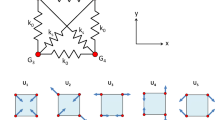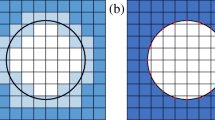Abstract
In this paper, we present a methodology for optimizing the locations of supports in arbitrary plate structures. We adopt a feature mapping approach where the stiffness of the supports is projected onto the finite element mesh using smooth super-Gaussian radial functions. This effectively separates the design space from the analysis model and a compact optimization problem with a continuous design space is obtained. We develop three techniques that improve the obtained minima significantly, namely: continuation of the stiffness projection; control over the initial design; and numerical damping. These techniques make the optimization insensitive to the initial design and much more resilient to convergence to local minima. Furthermore, the proposed method is not sensitive to the finite element mesh density, so coarse meshes may be used to reduce the computational cost. Results show that the optimal locations of supports are not trivial, especially in complex plate geometries, and that asymmetric distributions of supports may be optimal even if the plate is symmetric.

















Similar content being viewed by others
References
Bathe KJ (2006) Finite element procedures. Massachusetts Institute of Technology, Cambridge
Bendsøe MP (1989) Optimal shape design as a material distribution problem. Struct Optim 1(4):193–202
Buhl T (2002) Simultaneous topology optimization of structure and supports. Struct Multidisc Optim 23(5):336–346
Coniglio S (2019) Optimisation topologique à formalisme eulérien et lagrangien appliquée à la conception d’un ensemble propulsif. Universite de Toulouse (PhD thesis)
Coniglio S, Morlier J, Gogu C, Amargier R (2020) Generalized geometry projection: a unified approach for geometric feature based topology optimization. Arch Comput Methods Eng 27(5):1573–1610
Denli H, Sun J (2008) Optimization of boundary supports for sound radiation reduction of vibrating structures. J Vib Acoust 10(1115/1):2776345
Friswell MI, Wang D (2007) The minimum support stiffness required to raise the fundamental natural frequency of plate structures. J Sound Vib 301(3–5):665–677
Fuchs MB, Brull MA (1979) A new strain energy theorem and its use in the optimum design of continuous beams. Comput Struct 10(4):647–657
Guo X, Zhang W, Zhong W (2014) Doing topology optimization explicitly and geometrically—a new moving morphable components based framework. J Appl Mech. https://doi.org/10.1115/1.4027609
Jang GW, Shim HS, Kim YY (2009) Optimization of support locations of beam and plate structures under self-weight by using a sprung structure model. J Mech Des. https://doi.org/10.1115/1.3042154
Jihong Z, Weihong Z (2006) Maximization of structural natural frequency with optimal support layout. Struct Multidisc Optim 31(6):462–469
Komkov V, Choi KK, Haug EJ (1986) Design sensitivity analysis of structural systems, vol 177. Academic Press, New York
Kong J (2009) Vibration of isotropic and composite plates using computed shape function and its application to elastic support optimization. J Sound Vib 326(3–5):671–686
Korade A, Rakshit S (2020) Optimum support layout design for periodically loaded structures using topology optimization. Advances in structural vibration. Springer, New York, pp 149–156
Lee S, Kwak BM (2008) Smooth boundary topology optimization for eigenvalue performance and its application to the design of a flexural stage. Eng Optim 40(3):271–285
Menassa R, DeVries W (1991) Optimization methods applied to selecting support positions in fixture design. J Eng Ind. https://doi.org/10.1115/1.2899715
Mindlin RD (1951) Influence of rotatory inertia and shear on flexural motions of isotropic, elastic plates. J Appl Mech 18:31–38
Mróz Z, Rozvany G (1975) Optimal design of structures with variable support conditions. J Optim Theory Appl 15(1):85–101
Norato J, Haber R, Tortorelli D, Bendsøe MP (2004) A geometry projection method for shape optimization. Int J Numer Meth Eng 60(14):2289–2312
Norato J, Bell B, Tortorelli DA (2015) A geometry projection method for continuum-based topology optimization with discrete elements. Comput Methods Appl Mech Eng 293:306–327
Reissner E (1945) The effect of transverse shear deformation on the bending of elastic plates. J Appl Mech 12:A69–A77
Sigmund O, Torquato S (1997) Design of materials with extreme thermal expansion using a three-phase topology optimization method. J Mech Phys Solids 45(6):1037–1067
Son JH, Kwak BM (1993) Optimization of boundary conditions for maximum fundamental frequency of vibrating structures. AIAA J 31(12):2351–2357
Svanberg K (1987) The method of moving asymptotes—a new method for structural optimization. Int J Numer Meth Eng 24(2):359–373
Szeląg D, Mróz Z (1978) Optimal design of elastic beams with unspecified support conditions. ZAMM Z Angew Math Mech [J Appl Math Mech] 58(11):501–510
Wang D (2004) Optimization of support positions to minimize the maximal deflection of structures. Int J Solids Struct 41(26):7445–7458
Wang D, Jiang J, Zhang W (2004) Optimization of support positions to maximize the fundamental frequency of structures. Int J Numer Meth Eng 61(10):1584–1602
Wein F, Stingl M (2018) A combined parametric shape optimization and ersatz material approach. Struct Multidisc Optim 57(3):1297–1315
Wein F, Dunning PD, Norato JA (2020) A review on feature-mapping methods for structural optimization. Struct Multidisc Optim 62:1–42
Won KM, Park YS (1998) Optimal support positions for a structure to maximize its fundamental natural frequency. J Sound Vib 213(5):801–812
Funding
This research was funded by the Ministry of Construction and Housing, Israel. The financial support is gratefully acknowledged.
Author information
Authors and Affiliations
Corresponding author
Ethics declarations
Conflict of interest
The authors declare that they have no conflict of interest.
Replication of results
To preform replication of the results presented in this paper, all parameter settings and implementation aspects have been described in detail in the paper. In addition, upon request an executable code file and associated data will be provided for research and education purposes.
Additional information
Responsible Editor: Xu Guo
Publisher's Note
Springer Nature remains neutral with regard to jurisdictional claims in published maps and institutional affiliations.
Appendix: Optimization parameters
Appendix: Optimization parameters
In this annex, we will provide the values of all parameters as used in the current study. As mentioned, in this study we used the MMA algorithm with all parameters set to their default. However, we scaled the compliance functional (and derivatives) by \({1\times 10^{-4}}\) so that a reasonable number of inner MMA iterations will be required for convergence of the MMA iterations. Other parameters are listed in Table 3.
Rights and permissions
About this article
Cite this article
Zelickman, Y., Amir, O. Optimization of plate supports using a feature mapping approach with techniques to avoid local minima. Struct Multidisc Optim 65, 31 (2022). https://doi.org/10.1007/s00158-021-03135-3
Received:
Revised:
Accepted:
Published:
DOI: https://doi.org/10.1007/s00158-021-03135-3




